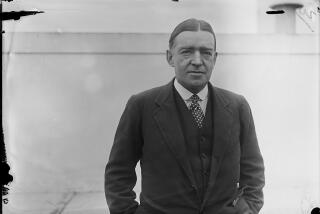A Failed Expedition Gets a Photo Finish
- Share via
NEW YORK — Eighty-three years ago, a young Australian photographer stripped to the waist, dove into 4 feet of Antarctic ice-floe slush and retrieved glass plate negatives from a sunken ship’s refrigerator.
The photographs that were saved in that heroic, some might say foolhardy, act reveal the drama, beauty and adventure of the failed 1914-15 Antarctic expedition of the Endurance.
More than 150 pictures by expedition photographer Frank Hurley, printed from his original negatives and album of prints, are on display at the American Museum of Natural History in New York from Saturday to Oct. 11.
The exhibit is the most comprehensive showing of Hurley’s expedition work ever. Only limited photographs--some taken with an early Kodak camera--have been on view in London since the 1920s. They tell one of the world’s greatest, yet least known, expedition survival tales.
“As we approach the millennium, the heroism of Sir Ernest Shackleton and the moving tale of his incredible voyage are being recognized as never before,” said Ellen Futter, president of the American Museum of Natural History.
In late 1914, Shackleton set out on an expedition with 27 other men to do what had never been done: cross the cold and forbidding Antarctic continent on foot from the Wedell Sea to the Ross Sea. They were not heard from again for nearly two years.
Their quest began on the eve of World War I and on the heels of the doomed 1913 expedition in which Capt. Robert Falcon Scott and his seven companions died while attempting to reach the South Pole on foot. Both events overshadowed Shackleton’s expedition, as did the fact that Scott was beaten to the pole by Norwegian explorer Roald Amundsen.
“Antarctic exploration of the early 20th century was unlike exploration of anywhere else on Earth. Here, with wind speeds up to nearly 200 miles an hour and temperatures as extreme as minus 100 degrees Fahrenheit, the essential competitions were pure and uncomplicated, being between man and the unfettered force of raw Nature and man and the limits of his own endurance,” wrote Caroline Alexander, guest curator of the exhibit, in her best-selling book, “The Endurance: Shackleton’s Legendary Antarctic Expedition.”
Hurley’s photographs, set out in chronological order at the exhibit, show in stark black and white the perils that men of the “Heroic Age” faced in conquering the poles.
The ship spent 10 months frozen like a wooden Popsicle stick before the inexorable pressure of the pack ice crushed and sank her in 1915.
More to Read
Sign up for The Wild
We’ll help you find the best places to hike, bike and run, as well as the perfect silent spots for meditation and yoga.
You may occasionally receive promotional content from the Los Angeles Times.






